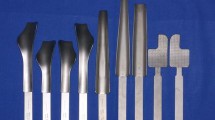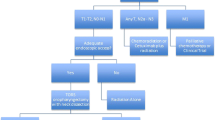Abstract
The objective of this study was prospectively to assess the feasibility and safety of transoral robotic surgery (TORS) in head and neck carcinomas and to report our learning curve and 2-year outcomes. Patients with oropharyngeal, hypopharyngeal and laryngeal tumors treated with TORS were prospectively included. We evaluated: the feasibility of TORS, robotic set-up time, transoral robotic surgery time, blood loss, surgical margins, tracheotomy, feeding tube, time to oral feeding and surgery-related complications. Twenty-three patients were treated for 25 carcinomas. Twenty-two patients underwent successful robotic resection for 24 carcinomas (96%). One patient required conversion to open surgery due to massive bleeding. The mean robotic set-up time was 25 min (range: 15–100 min) and mean TORS operating time was 70 min (range: 20–150 min). Positive margin of resection was observed in one patient (classified pT3) out of the 24 cancers and was managed by postoperative chemoradiation. No tracheotomy was performed. Three patients required prolonged intubation for a mean of 22 h. Two patients required a temporary gastrostomy (for 2 and 3.5 months, respectively). All other patients resumed oral feeding between the first and third postoperative day. The mean hospital stay was 6.4 days (range: 4–19 days). No postoperative complication occurred. Mean follow-up was 20 months (median: 19, range: 14–26). No death and no case of local or metastatic failure were observed. TORS is feasible and safe for the resection of selected head and neck carcinomas. The occurrence of intraoperative bleeding emphasizes the need for surgeons to be skilled in both transoral and open approaches.

Similar content being viewed by others
References
Mc Leod IK, Mair EA, Melder PC (2005) Potential applications of the Da Vinci minimally invasive surgical robotic system in otolaryngology. Ear Nose Throat J 84:483–487
Hockstein NG, Nolan JP, BWJr O’Malley, Woo YJ (2005) Robot-assisted pharyngeal and laryngeal microsurgery: results of robotic cadaver dissections. Laryngoscope 115:1003–1008
Weinstein GS, O’Malley BW Jr, Hockstein NG (2006) Transoral robotic surgery: supraglottic laryngectomy in a canine model. Laryngoscope 11:1315–1319
O’Malley BW Jr, Weinstein GS, Hockstein NG (2006) Transoral robotic surgery (TORS): glottic microsurgery in a canine model. J Voice 20:263–268
Weinstein GS, O’Malley BW, Snyder W (2007) Transoral robotic surgery tonsillectomy. Arch Otolaryngol Head Neck Surg 133:1220–1226
Moore EJ, Olsern KD, Kasperbauer JL (2009) Transoral robotic surgery for oropharyngeal squamous cell carcinoma: a prospective study of feasibility and functional outcomes. Laryngoscope 119:2156–2164
Genden EM, Desai S, Sung CK (2009) Transoral robotic surgery for the management of head and neck cancer: a preliminary experience. Head Neck 31:283–289
Boudreaux BA, Rosenthal EI, Magnuson JS, Newman JR, Desmond RA, Clemons L, Carroll WR (2009) Robot-assisted surgery for upper aerodigestive tract neoplasms. Arch Otolaryngol Head Neck Surg 135:397–401
Weinstein GS, Quon H, O’Malley BW Jr, Kim GG, Cohen MA (2010) Selective neck dissection and deintensified postoperative radiation and chemotherapy for oropharyngeal cancer: a subset analysis of the University of Pennsylvania transoral robotic surgery trial. Laryngoscope 120:1749–1755
White HN, Moore EJ, Rosenthal EL et al (2010) Transoral robotic-assisted surgery for head and neck squamous cell carcinoma: one- and 2-year survival analysis. Arch Otolaryngol Head Neck Surg 136:1248–1252
Weinstein GS, O’Malley BW Jr, Cohen MA, Quon H (2010) Transoral robotic surgery for advanced oropharyngeal carcinoma. Arch Otolaryngol Head Neck Surg 136:1079–1085
Genden EM, Park R, Smith C, Kotz T (2011) The role of reconstruction for transoral robotic pharyngectomy and concomitant neck dissection. Arch Otolaryngol Head Neck Surg 137:151–156
Hurtuk A, Agrawal A, Old M, Teknos TN, Ozer E (2011) Outcomes of transoral robotic surgery: a preliminary clinical experience. Otolaryngol Head Neck Surg 145:248–253
Iseli TA, Kulbersh BD, Iseli CE, Carroll WR, Rosenthal EL, Magnuson JS (2009) Functional outcomes after transoral robotic surgery for head and neck cancer. Otolaryngol Head Neck Surg 141:166–171
Lawson G, Matar N, Remacle M, Jamart J, Bachy V (2011) Transoral robotic surgery for the management of head and neck tumors: learning curve. Eur Arch Otorhinolaryngol [Epub ahead of print]
Sobin LH, Wittekind C (2002) UICC International Union Against Cancer. TNM classification of malignant tumors, 6th ed. Wiley, New York, pp 36–42
Remacle M, Eckel HE, Antonelli A et al (2000) Endoscopic cordectomy. A proposal for a classification by the Working Committee European Laryngological Society. Eur Arch Otorhinolaryngol 257:227–231
Byers RM (1994) Anatomic correlates in head and neck surgery. The lateral pharyngotomy. Head Neck 16:460–462
Solares CA, Strome M (2007) Transoral robot-assisted CO2 laser supraglottic laryngectomy: experimental and clinical data. Laryngoscope 117:817–820
Desai SC, Sung CK, Jang DW, Genden EM (2008) Transoral robotic surgery using a carbon dioxide flexible laser for tumors of the upper aerodigestive tract. Laryngoscope 118:2187–2189
Fried MP, Sadoughi B, Gibber MJ et al (2010) From virtual reality to the operating room: the endoscopic sinus surgery simulator experiment. Otolaryngol Head Neck Surg 142:202–207
Park YM, Kim WS, Byeon HK, De Virgilio A, Jung JS, Kim SH (2010) Feasibility of transoral robotic hypopharyngectomy for early-stage hypopharyngeal carcinoma. Oral Oncol 46:597–602
Flores TC, Wood BG, Levine HL, Koegel L Jr, Tucker HM (1982) Factors in successful deglutition following supraglottic laryngeal surgery. Ann Otol Rhinol Laryngol 91:579–583
Lee HK, Goepfert H, Wendt CD (1990) Supraglottic laryngectomy for intermediate-stage cancer. UT MD Anderson Cancer Center experience with combined therapy. Laryngoscope 100:831–836
Conflict of interest
The authors declare that they have no conflict of interest.
Author information
Authors and Affiliations
Corresponding author
Rights and permissions
About this article
Cite this article
Hans, S., Badoual, C., Gorphe, P. et al. Transoral robotic surgery for head and neck carcinomas. Eur Arch Otorhinolaryngol 269, 1979–1984 (2012). https://doi.org/10.1007/s00405-011-1865-7
Received:
Accepted:
Published:
Issue Date:
DOI: https://doi.org/10.1007/s00405-011-1865-7




